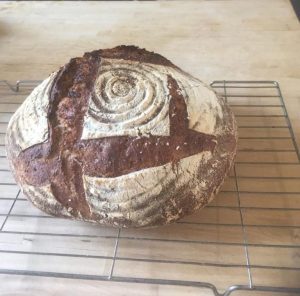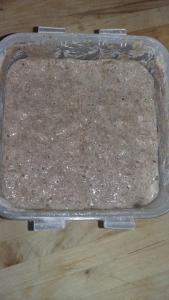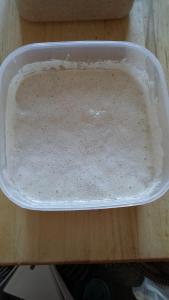This is for all you bakers, anyone who eats bread or makes it, anyone wondering how to keep your sourdough going in difficult times. It’s not a serious problem of survival and safety like looking after humans or other animals but you might still be wondering what will happen to your sourdough starter after months or years of careful nurturing if you can’t get hold of any flour. I care because I’ve finally learnt how to make a decent loaf like this, after going to some Bread Ahead classes along with friends and relatives. Wonderfully they are now doing live online baking via Instagram. Check it out!

Here’s what I’ll be doing after I failed to find any bread flour to buy, and can’t tell how long that situation will last. I started with a recce – how much flour do I have left of which types and how long will it last? I don’t have much rye flour, so won’t be making any more of the Borodinsky rye (of which more later) and will save it all for my rye sourdough starter which currently looks like this straight from the fridge:

I’m going to put half of it aside to freeze, and keep the other half to feed and use occasionally. It looks dark because I use wholemeal rye to feed it, and at the moment I can tell it’s still very healthy as it floats when added to water (a good tip from Bread Ahead). I also had some white sourdough starter which I’d been feeding with strong bread flour. I decided to experiment and divide it in two, feeding one lot as usual. It now looks like this, also straight from the fridge:

I reckon that’s also fairly healthy. But the experimental half, fed with ordinary plain flour, now looks different:

So I’m thinking that’s not so great as the little yeast plants seem to consume their food at a faster rate, or something. I’ve added a little bit of rye flour to the mix and will then use it all up in an experimental bake with an added touch of dried yeast and a mix of white and wholemeal. It may end up as rolls, easy to freeze and eke out. Photo coming soon.
My flour audit means I can now calculate how many wholemeal loaves I can make with dried yeast, and how many half and half sourdough loaves, before my stock runs out. If that happens at least I’ll know there’s some frozen sourdough starter that might make it through. As for other types of flour, I’ve got some atta that’s for chapattis and though it’s apparently possible to use it for some strange breadlike concoction I reckon it’s best used as intended – all you need is water, rolling pin and wide heavy frying pan. Self-raising and plain plus baking soda equals soda bread which can be made with sour milk or thin yoghurt.
The Borodinsky Rye sounds to me like it should be a dance so I’ve come up with a tune for it. Watch out for that in a future post. And now for something far more interesting.
The Elephant Dentist is returning here as I’m currently stopped from doing so many other things, like everyone else. While I was away, as a postgrad at UCL I researched and completed a lengthy dissertation on the (now historic) Jewish community of Mosul. I came across this article.
How did they used to make bread in Mosul? [‘They’ here meaning the Jews of Mosul.]
This question was posed directly by a Professor of Arabic, Otto Jastrow, to the late Ezra Laniado and his wife Ilana. He interviewed them in order to get them talking naturally and record their speech as he was interested in the Mosuli Jewish-Arabic dialect. I’ve inserted a few explanations in italics.
“ How does one bake bread in Iraq, in Mosul? First you go to the Feast of Tabernacles [Succot, festival occurring in early autumn] to buy the bread wheat. You wash it and rise it until Winter. You store it in the cellar, or attic, or larder. When you want to use it, you take it, in one or two sacks, to the Mill. The Miller grinds it, and lays it on to a donkey and brings it back to your home.
Once you return it home, you sieve it so as to remove the bran. Then, you sieve it a second time, and separate out the coarser flour, which is used to make wholemeal bread. Then you sieve out the pure/white flour out to make bread.
How does one make bread? First, the pastry (dough) cook(?) [female] [these precise job titles don’t seem to have an exact translation but it’s clear from the original language that they refer to women] comes in and places the flour into a level tub and stirs in the water. They add the yeast. When the dough has risen, they knead it with their hands until done. Once the dough has been kneaded once more, they take it to the baker’s [female] house. The baker separates the dough into pieces, each of which will make a loaf.
Here, there are sat more women. They roll out the dough with a rolling pin on a marble plate called fags with a rolling pin called Sobak.
After working with the rolling pin, she hands to the woman next to her to work, and again she passes it on, and again, working with the nassabe.
Ilana: one works with her hands, another with the rolling pin, a third with the nassabe. Yes the first flattens with her hands, the second rolls it further, the third rolls it flatter with the nassabe. The nassable is a round bit of wood but thinner than the sobak. Once the dough has been fully rolled, it looks as a circle with a diameter of about a metre. The dough is passed to the baker, who uses a (paddle?) and pops it into the oven. There are two types of oven; one is in the earth, and the baker places it deep inside. Beforehand, the baker takes wood, dung and whatever else and starts the fire. When the oven is hot she places it inside, and when the loaf is baked she pulls it from the (wall) of the oven and folds it together.
She folds each loaf twice, so that it looks like a triangle, and places into the bread basket. The baker takes a loaf as well as her payment, as does the dough mixer. Each family baked once a week, or once every ten days, or once a fortnight. Once the bread was done, you brought it into your house and stored it in a bread-storer. When you needed bread, you took from your store until the supplies were depleted. You sprinkled it with water first, to make it soft. You didn’t eat it dry. One bit of bread you would crumble off and eat with your soup under the lime trees.
So what of the wholemeal bread? You remember we have sieved the bran. The bran is often sold as animal feed. There is also the wheat from the second sieving, which you can bake and eat, but which is often gifted to the poor. Thus the bread of the Jews in Mosul was from the 3rd sieving.
The Jews of Mosul also baked small, fat loaves (qawas). This was baked in the same way. The fatter loaves were eaten in the morning, with (buffalo?) cream and taken with tea. The thinner bread was eaten at lunch and dinner. In the morning you might buy bread from the Muslims at the marketplace. That was warm bread, warm qawas which you ate in the morning. You’d buy it with (buffalo?) cream or whole milk, with honey or sesame oil, whatever you wanted. You’d bring it home, eat it with milk or tea. You’d eat it for breakfast. Of those who lived in difficult circumstances/relationships, you’d say they live off the market. They couldn’t afford to buy the wheat for themselves.
Bread for Pesach [Passover]: This was different that the standard bread as it had to be unleavened. You would have to mix it separately, so that it didn’t become leavened. For the first, you would clean the wheat carefully, and also with barley, as barley is not allowed at Pesach. At Pesach you would wash the wheat carefully and also the stone, so that it did not contaminate. This you would do one month before Pesach, and store it separately so that it did not get contaminated. This bread you would bake in exactly the same way, sieve it and remove the bran, however you would not wait for it to rise. This bread we called matzah. As our ancestors were expelled from Egypt, they didn’t wait for it to rise, and so it ate it unleavened. For this reason at Pesach each year we ate matzah. As well as this bread you would make thicker bread, called massa, and made like qawas. We say our prayers over the matzah. The massa we would eat for celebrations, weddings and such, and you’d eat it with lots of sesame seeds, or sugar perhaps. We would eat this at joyous occasions and sweeten it and share it with friends and other households. “
Shout out to Joel Attar who translated this from Jastrow’s article in German. Jastrow made the original translation into German. Reference here:
Brotbacken: Ein Text im arabischen Dialekt der Juden von Mossul in memoriam Ezra Laniado. Zeitschrift für Arabische Linguistik, No. 23 (1991), pp. 7-13. https://www.jstor.org/stable/43615773
Bookmark this site for your regular entertainment and some sharing of possibly obscure information. I’m going to be running a series on an extraordinary work from over a century ago and why it’s relevant now, Cassell’s Book of the Home, which has repelled and fascinated me for years.



